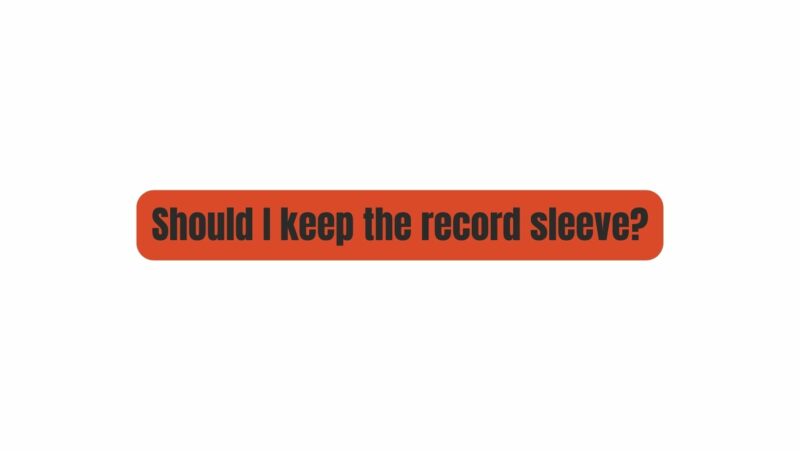In the world of vinyl records, the question of whether to keep the record sleeve is one that often plagues collectors and enthusiasts. Some view the record sleeve as an essential part of the vinyl experience, while others may see it as nothing more than a protective cover. To answer this question, we’ll delve into the multifaceted aspects of record sleeves and explore the reasons why you might want to consider keeping them.
Preserving the Vinyl
One of the primary purposes of a record sleeve is to protect the vinyl itself. Vinyl records are sensitive to dust, moisture, and scratches. Without a protective sleeve, the grooves on the vinyl can accumulate dust and debris, leading to a decrease in sound quality over time. Additionally, contact with other records or hard surfaces can result in scratches and damage.
Keeping the record sleeve, particularly if it’s an anti-static inner sleeve, helps safeguard the vinyl from these potential harms. It’s a practical choice for those who want to ensure their records remain in optimal condition for years to come.
Protecting the Album Cover
While the primary function of the outer record sleeve is to safeguard the vinyl, the inner sleeve plays a vital role in protecting the album cover. Album covers are not just a means of packaging; they are a canvas for artistic expression. Many iconic album covers are celebrated for their visual artistry and the stories they tell.
By keeping the record sleeve, you help prevent wear and tear on the album cover. This is particularly important if you own vintage or collectible records, as preserving the cover’s condition can significantly impact the album’s value. Moreover, having an intact album cover allows you to fully appreciate the artwork and design that accompanied the music.
Enhancing Sound Quality
Sound quality is paramount for vinyl enthusiasts, and the choice to keep the record sleeve can have an impact. Some inner sleeves, such as those made from anti-static polyethylene or polypropylene, are designed to reduce static and minimize friction when removing the record. This can result in less surface noise and better overall sound quality during playback.
Furthermore, the outer sleeve can act as an additional layer of protection against environmental factors that could affect sound quality, such as humidity or exposure to direct sunlight. In this sense, keeping both the inner and outer sleeves can contribute to a superior listening experience.
Nostalgia and Collectibility
For many vinyl collectors and music enthusiasts, record sleeves hold a special place in their hearts. The act of holding a record sleeve can evoke feelings of nostalgia and a connection to the past. It transports individuals to a time when music was experienced in a more tactile and sensory way, and the record sleeve was an integral part of that experience.
Moreover, record sleeves can be collectible items in their own right. Limited edition sleeves, unique artwork, and promotional sleeves often have value to collectors. By keeping these sleeves in good condition, you not only preserve the history of music but also potentially increase their worth as collector’s items.
Organizational Benefits
Another practical consideration for keeping record sleeves is organization. Vinyl collectors often have extensive collections, and having the record sleeves on hand makes it easier to locate and identify specific records. The sleeves can serve as a visual reference, helping you quickly find the album you want to listen to without having to pull out each record individually.
In addition, record sleeves can include useful information such as tracklists, credits, and production notes. Keeping the sleeves allows you to access this information easily, enhancing your overall music appreciation and knowledge.
Sleeve Alternatives
While keeping record sleeves is a popular choice among vinyl enthusiasts, it’s worth mentioning that there are alternatives. Some collectors opt for replacing the original sleeves with specialized inner sleeves, such as paper or poly-lined sleeves, which offer superior protection and reduce static. This choice combines the benefits of sleeve preservation with enhanced protection for the vinyl and cover.
Ultimately, the decision to keep the record sleeve comes down to personal preference and priorities. Some collectors prioritize the preservation of the original packaging, while others may prioritize sound quality above all else.
Conclusion
In the end, the question of whether to keep the record sleeve is a matter of individual choice. However, as we’ve explored, there are compelling reasons to consider preserving both inner and outer record sleeves. From protecting the vinyl and album cover to enhancing sound quality and preserving the nostalgia of the vinyl experience, keeping the record sleeve can enrich your enjoyment of vinyl records.
While there are alternatives to the traditional sleeves, many collectors find that the original sleeves offer a unique connection to the past and the artistry of music. So, the next time you’re faced with the decision of whether to keep the record sleeve, remember that it’s not just a protective cover—it’s a piece of music history and a key to unlocking the full potential of your vinyl collection.
In the end, the choice is yours, but the record sleeve is more than just a cover; it’s a bridge to the past and a treasure worth preserving.

